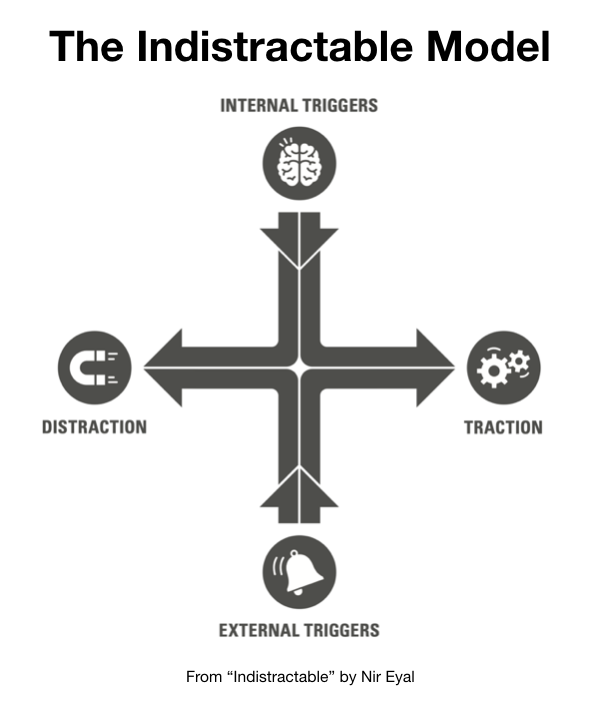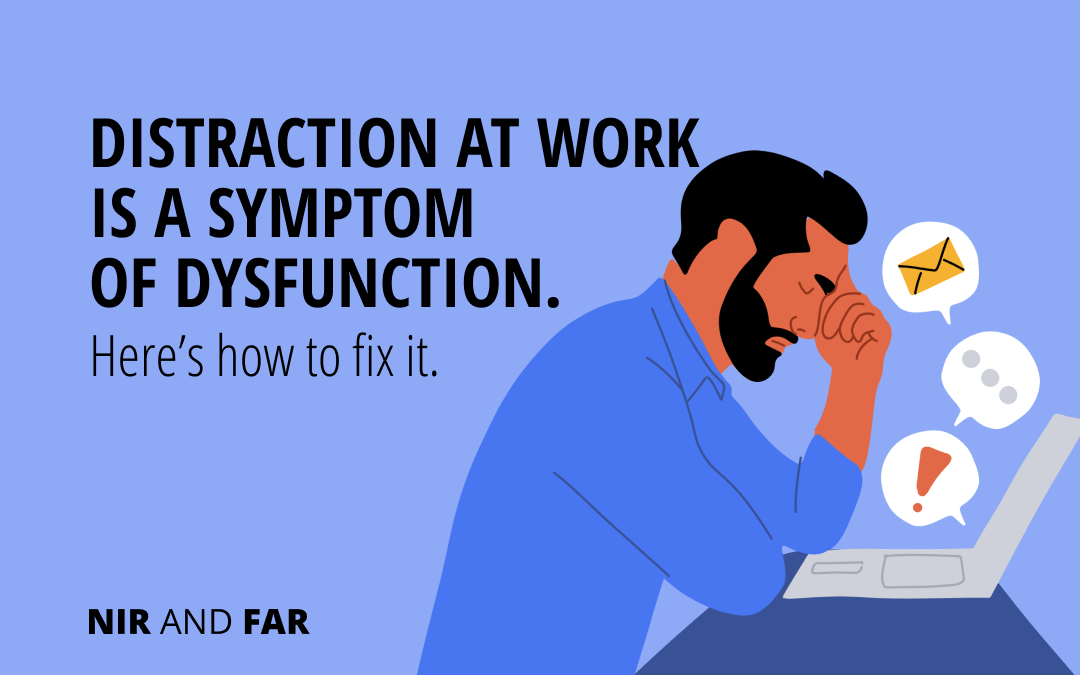It seems we’re all checking our phones constantly these days. But all that time spent on our phones leaves little time for anything else.
We need time to think in order to come up with novel solutions to our business challenges.
We need uninterrupted time to reflect, rather than constantly react to every distraction. If we can’t focus, we can’t do our best work.
With the rise of technologies like the smartphone, a question on many managers’ and business leaders’ minds is, “How can I help employees stay focused instead of constantly succumbing to distractions at work?”
The four steps described in the new book, Indistractable: How to Control Your Attention and Choose Your Life, are a guide for overcoming distraction and doing our best work.

Action, Traction, and Distraction
Traction and distraction are categories of actions: our actions either contribute to our progress or inhibit it.
“Traction” refers to any action that moves us closer to what we really want, while “distraction” is the opposite—any action that moves us away from what we really want. Traction is what happens when we do as we say; distraction is what happens when we betray our best intentions.
Triggers: Internal vs. External
Each of our actions is driven by a trigger, either external or internal.
Internal triggers are cues that originate within us. They are negative sensations or emotions that prompt us to take action to address the unpleasant feeling.
For example, a common internal trigger is workplace stress. When we feel stress, we seek to escape the negative sensation and might check our phones, check email, or find some other way to feel better.
External triggers are cues from our environment and may include other people, objects, and sounds. When it comes to our devices, the pings, dings, and rings emanating from our phones are all external triggers that lead to either traction or distraction.
How to Build an Indistractable Workplace
The Indistractable Model helps us understand why we get distracted. Our behaviors originate from either internal or external triggers, and they lead us to either traction or distraction. How can we apply this framework to help our colleagues minimize distraction and maximize productive focus?
While there are many things individuals can do to manage distraction by using all four parts of the Indistractable Model, as leaders, we should recognize our role in perpetuating distraction at work.
If distraction is often spurred by internal triggers, the uncomfortable sensations leading us to seek relief, we must understand how certain business environments perpetuate these negative states.
There are three things we can do to create an indistractable workplace:
- Empower People with Channels for Feedback
- Foster Psychological Safety
- Model Being Indistractable
Empower People with Channels for Feedback
Though we like to blame our technology, distraction at work is a sign of dysfunction.
As a manager, you can fix the root cause of the problem by creating an environment where employees feel management is listening to their concerns and is open to their feedback. Leveraging referent power can help in this regard by fostering a sense of respect and admiration, which in turn encourages open communication. When people don’t have a way to initiate change at work, they feel frustrated and powerless, and feeling powerlessness can be a powerful internal trigger of distraction.
When people feel like they have little influence, they’re driven to seek a sense of control in other ways. Often this manifests itself in distracting, corrosive behaviors like corporate politicking or time-wasting “pseudo-work,” unintentionally making work that isn’t aligned with the company’s real objectives.
There are many ways to solicit feedback. The important thing is to ensure feedback channels exist and that individual employees believe their voices matter.
By replacing a feeling of powerlessness with a sense of agency and control, companies cut off an internal trigger that often leads to distraction.
Foster Psychological Safety
If you give your employees a channel to provide feedback, but they fear reprisals for sharing their thoughts, you will not reap the benefits.
Asking employees for feedback won’t work without “psychological safety.”
Psychological safety is a sense of security that comes from knowing that you will not be punished for raising concerns.
Fostering psychological safety is imperative if you want to build a culture where employees are motivated to do their best work.
Here are some ways to build psychological safety:
- Frame the work you do as a “learning problem” that requires participation from everyone; show your employees that you want and need their unique and valuable contribution.
- Never penalize an employee for sharing feedback with you. At some point, you will almost certainly receive feedback that feels personal and painful. When you do, commit to hearing it with an open mind and refraining from any sort of backlash toward the employee.
- Practice humility. Don’t be afraid to make mistakes, to say “I don’t know,” and to be vulnerable and open with your employees. Not only will they feel more comfortable doing the same, they will also trust you more and stay more open to learning.
When you build a culture of psychological safety, your employees will be less prone to distraction from internal triggers. Most importantly, you’ll create an environment where employees can speak openly about solving the problem of distraction.
With an open dialogue, they’ll be able to work together to tackle the external triggers that lead to distraction and customize a solution that fits your industry and company.
When people feel safe discussing their problems, they can find solutions to fix them.
Be A Model of Focused Work
Perhaps the most important thing you can do to encourage your employees to prioritize focused work is to model the behaviors you want to see.
Exemplify indistractability yourself, and they will be much more willing and able to do the same. Company culture flows from the top down. People pay attention not only to what you say but more importantly, to what you do.
Make time for focused work yourself. Let people know the times when you have booked it in your schedule, and let them know when you will be offline. Share how you identified your own internal and external triggers, and how you manage them to lead to traction rather than distraction. And of course, don’t interrupt people during their focused work time or off-hours.
Distractions at Work: Summary
Related Articles
- Schedule Maker: a Google Sheet to Plan Your Week
- Habit Tracker Template in Google Sheets
- The Ultimate Core Values List: Your Guide to Personal Growth
- Timeboxing: Why It Works and How to Get Started in 2024
- An Illustrated Guide to the 4 Types of Liars
- Hyperbolic Discounting: Why You Make Terrible Life Choices
- Happiness Hack: This One Ritual Made Me Much Happier

